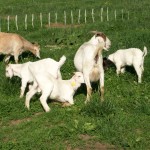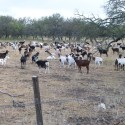Meat Goat Breeds and Types
The US goats meat goat industry was primarily supplied by cull fiber goats through the 1970’s. After that they were primarily utilized for brush control. However, with the decline of the fiber industry demand for goat meat started to turn to imported product and a very small number of meat goat producers. An increase in goat meat demand lead to an increase in producers that were raising goats for meat production.
Goat breeds are generally divided into three primary types: dairy, meat and fiber goats. Meat goat are the type that has seen the most rapid growth starting in the late 1990’s and early 2000’s. The rise in meat goat production really started with the importation of the Boer goat in the 1980’s which were seen as a very rapid growth breed with heavy muscling. This was a very different goat than the common brush or Spanish goat that most people were familiar with at the time. Many producers crossed the Boer with brush and Spanish goats resulting in heaver muscled, faster growing kids. This lead to a boom in goat production and the number of breeders increased greatly through the early 2000’s. There are five main breeds of meat goats today and several other breeds or composites that are being used by producers. The main breeds are:
Boer –
The Boer goat is a horned breed with lop ears from South Africa. The traditional Boer has short white hair and red markings on the head and neck. The original Boer goat was selected for meat production with good conformation, high growth rate and fertility. The Boer goat also has an extended breeding season making possible 3 kiddings every 2 years. Today this breed is the major meat breed.
Kiko –
The Kiko is a meat breed that was developed by crossing established breeds with New Zealand ferial goats. They were then selected for twinning, growth rate and constitution. The first large number of Kiko goats was impor
ted into the United States around 1992. The Kiko is large framed, generally white, though colored animals are acceptable, with a coat that ranges from slick in summer to flowing hair in winter.
NSIP Breed Representative
Ken Andries
Extension Specialist & Research Assistant Professor
107 Atwood
400 E Main St
Frankfort, KY 40601
office phone: 502-597-5094
cell phone: 502-229-7707
INSTRUCTIONS: If you put cursor over a pin and click the breeders information will appear. On some of the breeders maps the pins are so close together on the zoomed out map that you can not see all the pins marking individual breeders. For those situations I recommend clicking on the blue words below the map to see a larger version that also shows the list of breeders in alphabetical order along the side.



Sorry, comments are closed for this post.